Today, the Walt Disney Company is a diversified multinational mass media and entertainment conglomerate, even the world's largest independent media conglomerate in terms of revenue. On 16 October 1923, two brothers - Walt and Roy O. Disney - founded the Disney Brothers Cartoon Studio; later operating under the names The Walt Disney Studio and Walt Disney Productions. The company established itself as a leader in the American animation industry before diversifying into live-action film production, television, and theme parks. But it all started with Mickey Mouse, who was created in 1928 and is still the signature mascot and emblem for Disney.
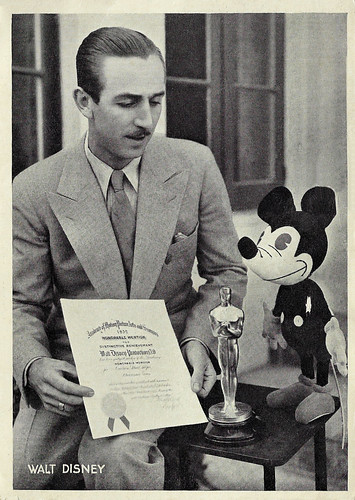
Vintage postcard. In 1932, Walt Disney received an honorary Academy Award for creating Mickey Mouse.
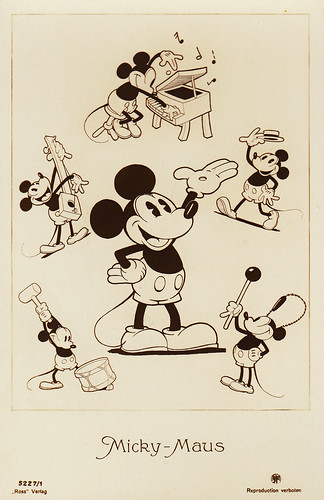
German postcard by Ross Verlag, no. 5227/1, 1930-1931. Image: Walt Disney. Collection: Marlene Pilaete.
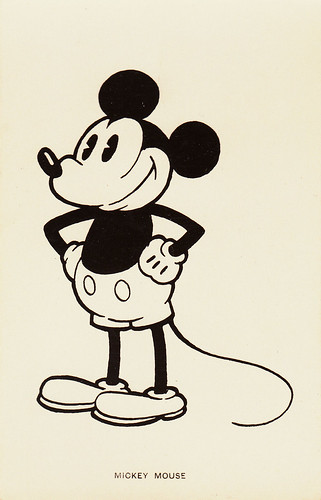
British postcard in the Picturegoer series. Image: Walt Disney. Collection: Marlene Pilaete.
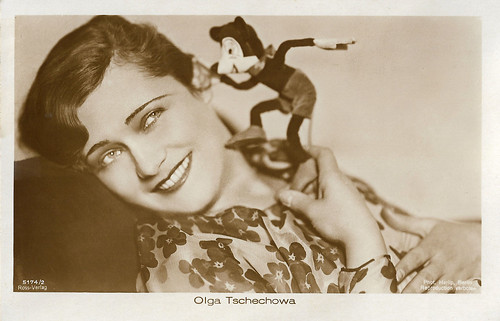
German postcard by Ross-Verlag, Berlin, no. 5174/2, 1930-1931. Photo: Harlip, Berlin. Mickey surrenders Europe and Olga Tschechova.

French postcard by Editions Superluxe, Paris, no. 14. Image: Walt Disney - Micky Mouse S.A.. Publicity still for Snow White and the Seven Dwarfs (William Cottrell, David Hand, Wilfred Jackson, Larry Morey, Perce Pearce, Ben Sharpsteen, 1937). Caption: To reward her little friends, Snow White serves them a tasty dinner.
In early 1923, animator Walt Disney created a short film entitled Alice's Wonderland, which featured child actress Virginia Davis interacting with animated characters. After the bankruptcy in 1923 of his previous firm, Laugh-O-Gram Studio, Disney moved to Hollywood to join his brother, Roy O. Disney. Film distributor Margaret J. Winkler of M.J. Winkler Productions contacted Disney with plans to distribute a whole series of Alice Comedies purchased for $1,500 per reel with Disney as a production partner.
Walt and Roy Disney formed Disney Brothers Cartoon Studio that same year. More animated films followed after Alice. In January 1926, with the completion of the Disney studio on Hyperion Street, the Disney Brothers Studio's name was changed to the Walt Disney Studio. Hundreds of Alice Comedies were produced between 1923 and 1927, before they lost popularity.
After the demise of the Alice Comedies, Disney developed an all-cartoon series starring his first original character, Oswald the Lucky Rabbit, which was distributed by Winkler Pictures through Universal Pictures. The distributor owned Oswald, so Disney only made a few hundred dollars.
From 1927 on, Disney completed 26 Oswald shorts before losing the contract in February 1928, due to a legal loophole, when Winkler's husband Charles Mintz took over their distribution company. After failing to take over the Disney Studio, Mintz hired away four of Disney's primary animators (the exception being Ub Iwerks) to start his own animation studio, Snappy Comedies.
In 1928, to recover from the loss of Oswald the Lucky Rabbit, Disney came up with the idea of a mouse character named Mortimer while on a train headed to California, drawing up a few simple drawings. The mouse was later renamed Mickey Mouse and starred in several Disney produced films. Ub Iwerks refined Disney's initial design of Mickey Mouse.
Disney's first sound film Steamboat Willie (Walt Disney, Ub Iwerks, 1928), a cartoon starring Mickey, was released in 1928 through Pat Powers' distribution company. It was the first Mickey Mouse sound cartoon released, but the third to be created, behind Plane Crazy (Walt Disney, Ub Iwerks, 1928), and The Gallopin' Gaucho (Walt Disney, Ub Iwerks, 1928).
Steamboat Willie, with Walt as the voice of Mickey, was an immediate smash hit, and its initial success was attributed not just to Mickey's appeal as a character, but to the fact that it was the first cartoon to feature synchronised sound. Disney's Plane Crazy and The Gallopin' Gaucho were then retrofitted with synchronised sound tracks and re-released successfully in 1929.
Disney continued to produce cartoons with Mickey Mouse and friends, including Minnie Mouse, Donald Duck, Goofy, Pluto, and plenty more. He began the Silly Symphony series, a cartoon series that didn't have a continuous character, with Columbia Pictures signing on as Symphonies distributor in August 1929. In September 1929, theatre manager Harry Woodin requested permission to start a Mickey Mouse Club which Walt approved. In November, test comics strips were sent to King Features, who requested additional samples to show to the publisher, William Randolph Hearst. On 30 December, King Features signed its first newspaper, New York Mirror, to publish the Mickey Mouse comic strip with Walt's permission.
In 1932, Disney signed an exclusive contract with Technicolor (through the end of 1935) to produce cartoons in colour. The first, Flowers and Trees (Burt Gillett, 1932), was also the first cartoon to win an Oscar. Another cartoon, Three Little Pigs (Burt Gillett, 1933), was so popular it was often billed above the feature films it accompanied. Disney released cartoons through Powers' Celebrity Pictures (1928–1930), Columbia Pictures (1930–1932), and United Artists (1932–1937). The popularity of the Mickey Mouse series allowed Disney to plan for his first feature-length animation. Criticasters called it "Disney's Folly".

French postcard in the series The Wonderful World of Walt Disney by Editions Kroma, Caissargues, no. 203. Image: Walt Disney Productions. Publicity still for Snow White and the Seven Dwarfs (William Cottrell, David Hand, Wilfred Jackson, Larry Morey, Perce Pearce, Ben Sharpsteen, 1937).

Dutch postcard by Rembrandt Uitg. Mij, Amsterdam. Image: Walt Disney. Publicity still for Pinocchio (Hamilton Luske, Ben Sharpsteen, a.o., 1940). Caption: "And Pinocchio danced on stage with the Dutch marionette girls..."

French postcard in the series The Wonderful World of Walt Disney by Editions Kroma, Caissargues, no. 6. Image: Walt Disney Productions. Publicity still for Fantasia (James Algar, Wilfred Jackson, Hamilton Luske, Ben Sharpsteen, a.o., 1940). Hyacinth Hippo and alligator dance partner in the segment Dance of the Hours.

French postcard by Editions Superluxe, Paris, no. 22. Sent by mail in 1953. Image: Walt Disney Productions. Publicity still for Dumbo (Ben Sharpsteen, a.o., 1941). Caption: This is the big jump, Dumbo will fly? Timothy lodged in his hat is worried.
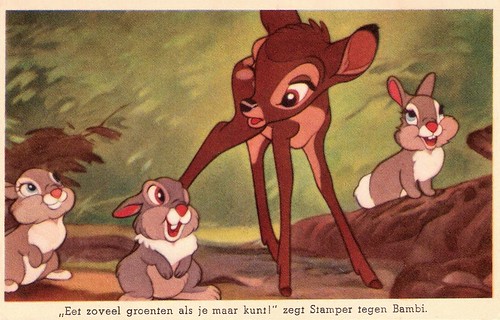
Dutch postcard by Rembrandt Uitg. Mij. Amsterdam, circa 1949. Publicity still for Bambi (David Hand, 1942). Caption: Eat as many vegetables as you can, Thumper says to Bambi.
Walt Disney decided to push the boundaries of animation further. He began production of his first feature-length animated film in 1934. Taking three years to complete, Snow White and the Seven Dwarfs (William Cottrell, David Hand, Wilfred Jackson, Larry Morey, Perce Pearce, Ben Sharpsteen, 1937), premiered in December 1937 and by 1939 became the highest-grossing film of that time. Snow Whitewas released through RKO Radio Pictures, which had assumed distribution of Disney's product in July 1937, after United Artists attempted to attain future television rights to the Disney shorts.
Using the profits from Snow White, Disney financed the construction of a new 51-acre (210,000 m2) studio complex in Burbank, California. The new Walt Disney Studios, in which the company is headquartered to this day, was completed and open for business by the end of 1939. The studio continued releasing animated shorts and features, such as Pinocchio (Hamilton Luske, Ben Sharpsteen, a.o., 1940), Fantasia (James Algar, Wilfred Jackson, Hamilton Luske, Ben Sharpsteen, a.o., 1940), Dumbo (Ben Sharpsteen, a.o., 1941), and Bambi (David Hand, 1942).
After World War II began, box office profits declined. When the United States entered the war after the attack on Pearl Harbor, many of Disney's animators were drafted into the armed forces. The U.S. and Canadian governments commissioned the studio to produce training and propaganda films. By 1942, 90% of its 550 employees were working on war-related films. Films such as the feature Victory Through Air Power (Perce Pearce, a.o., 1943) and the short Education for Death (Clyde Geronimi, 1943) were meant to increase public support for the war effort. Even the studio's characters joined the effort, as Donald Duck appeared in a number of comical propaganda shorts, including the Academy Award-winning Der Fuehrer's Face (Jack Kinney, 1943).
With limited staff and little operating capital during and after the war, Disney's feature films during much of the 1940s were 'package films', or collections of shorts, such as The Three Caballeros (Norman Ferguson, a.o., 1944) and Melody Time (Jack Kinney, Clyde Geronimi, Hamilton Luske, Wilfred Jackson, 1948), which performed poorly at the box office.
At the same time, the studio began producing live-action films and documentaries. Song of the South (Harve Foster, Wilfred Jackson, 1946) and So Dear to My Heart (Harold D. Schuster, Hamilton Luske, 1948) featured animated segments, while the True-Life Adventures series, which included such films as Seal Island (James Algar, 1948) and The Vanishing Prairie (James Algar, 1954), were also popular. Eight of the films in the series won Academy Awards.
The release of Cinderella (Clyde Geronimi, Hamilton Luske, Wilfred Jackson, 1950) proved that feature-length animation could still succeed in the marketplace. Other releases of the period included Alice in Wonderland (Clyde Geronimi, Wilfred Jackson, Hamilton Luske, 1951) and Peter Pan (Clyde Geronimi, Wilfred Jackson, Hamilton Luske, 1953), both in production before the war began, and Disney's first all-live action feature, Treasure Island (Byron Haskin, 1950). Disney ended its distribution contract with RKO in 1953, forming its own distribution arm, Buena Vista Distribution.
In December 1950, Walt Disney Productions and the Coca-Cola Company teamed up for Disney's first venture into television, the NBC television network special An Hour in Wonderland. In October 1954, the ABC network launched Disney's first regular television series.
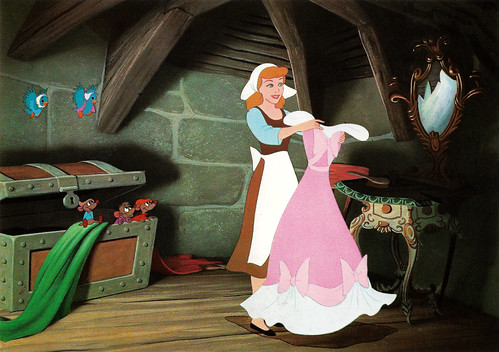
Italian postcard by Grafiche Biondetti, Verona, no. 104. Picture: Walt Disney Productions. Publicity still for Cinderella (Clyde Geronimi, Wilfred Jackson, Hamilton Luske, 1950).

Italian postcard by Grafiche Biondetti S.R.L., Verona, no. 108/4. Image: Disney. Publicity still for Lady and the Tramp (Clyde Geronimi, Wilfred Jackson, Hamilton Luske, 1955).

French card by Jouets Masport, Chanas (Isère), no. 39/882. Photo: Walt Disney. Fess Parker and Buddy Ebsen in Davy Crockett - King of the Wild Frontier/Davy Crockett (Norman Foster, 1955).

French postcard by Editions Krõma, Paris in the Le monde merveuilleux de Walt Disney series. Illustration: Walt Disney Productions. Publicity still for One Hundred and One Dalmatians (Clyde Geronimi, Hamilton Luske, 1961).

Italian postcard by Grafiche Biondetti S.R.L., Verona, no. 116/1. Image: Disney. Publicity still for The Sword in the Stone (Wolfgang Reitherman, 1963).
In 1954, Walt Disney used his Disneyland series to unveil what would become Disneyland, an idea conceived out of a desire for a place where parents and children could both have fun at the same time. In 1955, Disney opened Disneyland to the general public. After a shaky start, Disneyland continued to grow and attract visitors from across the country and around the world. In 1965, a second Disney theme park, Disney World', was announced, outside of Orlando, Florida.
Disney continued to focus its talents on television throughout the 1950s. Its weekday afternoon children's television program The Mickey Mouse Club (1955) was a great success, as was the Davy Crockett miniseries, starring Fess Parker and broadcast on the Disneyland anthology show. Two years later, Zorro (1957) would prove just as popular, running for two seasons on ABC.
Disney's film studios stayed busy as well, averaging five or six releases per year during this period. While the production of shorts slowed significantly during the 1950s and 1960s, the studio released a number of popular animated features, like Lady and the Tramp (Clyde Geronimi, Wilfred Jackson, Hamilton Luske, 1955), Sleeping Beauty (Clyde Geronimi, a.o., 1959) and One Hundred and One Dalmatians (Clyde Geronimi, Hamilton Luske, 1961), which introduced a new xerography process to transfer the drawings to animation cels.
Disney's live-action releases were spread across a number of genres, including the historical fiction film Johnny Tremain (Robert Stevenson, 1957), the children's book adaptation Pollyanna (David Swift, 1960) starring Hayley Mills, and the modern-day comedy The Shaggy Dog (Charles Barton, 1959), with Fred MacMurray.
Disney's most successful film of the 1960s was a musical adaptation of Mary Poppins (Robert Stevenson, 1964), which mixed live-action with animation. It is considered by many to be Walt Disney's magnum opus. Mary Poppins became one of the all-time highest-grossing films and received five Academy Awards, including Best Actress for Julie Andrews and Best Song for Robert B. Sherman & Richard M. Sherman for 'Chim Chim Cher-ee'.
In 1966, Walt Disney died of complications relating to lung cancer, and Roy Disney took over as chairman, CEO, and president of the company. One of his first acts was to rename Disney World as 'Walt Disney World' in honour of his brother and his vision. In 1967, the last two films Walt actively supervised were released, the animated feature The Jungle Book (Wolfgang Reitherman, 1967) and the musical The Happiest Millionaire (Norman Tokar, 1967).
The studio released a number of comedies in the late 1960s, including The Love Bug (Robert Stevenson, 1969), the year's highest-grossing film, and The Computer Wore Tennis Shoes (Robert Butler, 1969), which starred another young Disney discovery, Kurt Russell. The 1970s opened with the release of Disney's first 'post-Walt' animated feature, The AristoCats (Wolfgang Reitherman, 1970), followed by a return to fantasy musicals in Bedknobs and Broomsticks (Robert Stevenson, 1971) with Angela Lansbury.
In December 1971, Roy Disney died of a stroke. He left the company under control of Donn Tatum, Card Walker, and Walt's son-in-law Ron Miller, each trained by Walt and Roy. While Walt Disney Productions continued releasing family-friendly films throughout the 1970s, such as Escape to Witch Mountain (John Hough, 1975) and Freaky Friday (Gary Nielson, 1976) with Jodie Foster, the films did not fare as well at the box office as earlier material. However, the animation studio saw success with Robin Hood (Wolfgang Reitherman, 1973), The Rescuers (Wolfgang Reitherman, John Lounsbery, Art Stevens, 1977), and The Fox and the Hound (Ted Berman, Richard Rich, Art Stevens, 1981).
As head of the studio, Ron Miller attempted to make films to drive the profitable teenage market who generally passed on seeing Disney films. Inspired by the popularity of Star Wars (George Lucas, 1977), Disney produced the science-fiction adventure The Black Hole (Gary Nelson, 1979) that cost $20 million to make, but was lost in Star Wars' wake. Disney dabbled in the horror genre with The Watcher in the Woods (John Hough, Vincent McEveety, 1980) starring Bette Davis, and financed the boldly innovative Tron (Steven Lisberger, 1982) with Jeff Bridges, but both films were released to minimal success.
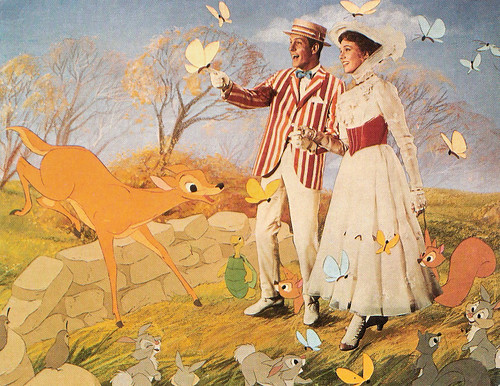
French postcard. Photo: Walt Disney Productions. Julie Andrews and Dick Van Dyke in Mary Poppins (Robert Stevenson, 1964).

Belgian postcard by Edicorna. Image: Walt Disney Productions. Publicity still for The Jungle Book (Wolfgang Reitherman, 1967).

Italian postcard by Grafiche Biondetti, no. 117. Illustration: Walt Disney Productions. Publicity still for The AristoCats (Wolfgang Reitherman, 1970).

Italian postcard by Grafiche Biondetti S.R.L., Verona. Image: Disney. Publicity still for Robin Hood (Wolfgang Reitherman, 1973).

French postcard by Les Presses de Belleville, Paris. Image: Walt Disney Productions, 1965. Publicity still for the short film Winnie the Pooh and the Honey Tree (Wolfgang Reitherman, 1966), later incorporated in the feature The Many Adventures of Winnie the Pooh (John Lounsbery, Wolfgang Reitherman, 1977).
The 1983 release of Mickey's Christmas Carol began a string of successful films, starting with Never Cry Wolf (Carroll Ballard, 1983) and the Ray Bradbury adaptation Something Wicked This Way Comes (Jack Clayton, 1983). In 1984, Disney CEO Ron Miller created Touchstone Films as a brand for Disney to release more major motion pictures. Touchstone's first release was the comedy Splash (Ron Howard. 1984), which was a box office success. In 1980, Disney launched Walt Disney Home Video to take advantage of the newly emerging videocassette market. In 1983, The Disney Channel debuted as a subscription-level channel on cable systems nationwide.
Despite the success of the Disney Channel and its new theme park creations, Walt Disney Productions was financially vulnerable. Its film library was valuable, but offered few current successes, and its leadership team was unable to keep up with other studios, particularly the works of Don Bluth, who defected from Disney in 1979. By the early 1980s, the parks were generating 70% of Disney's income.
With the Sid Bass family purchase of 18.7 percent of Disney, Bass and the board brought in Michael Eisner from Paramount as CEO and Frank Wells from Warner Bros. as president. Eisner emphasised Touchstone with Down and Out in Beverly Hills (Paul Mazursky, 1985) to start leading to increased output with Good Morning, Vietnam (Barry Levinson, 1987), Dead Poets Society (Peter Weir, 1989), Pretty Woman (Garry Marshall, 1990) and additional hits.
Beginning with Who Framed Roger Rabbit (Robert Zemeckis, 1988), Disney's flagship animation studio enjoyed a series of commercial and critical successes with such films as The Little Mermaid (Ron Clements, John Musker, 1989), Beauty and the Beast (Gary Trousdale, Kirk Wise, 1991), Aladdin (Ron Clements, John Musker, 1992) and The Lion King (Roger Allers, Rob Minkoff, 1994). Disney moved to first place in box office receipts by 1988 and had increased revenues by 20% every year. In 1989, Disney signed an agreement-in-principle to acquire The Jim Henson Company from its founder, Muppet creator Jim Henson.
Disney also broadened its adult offerings in film when then-Disney Studio Chairman Jeffrey Katzenberg acquired Miramax Films in 1993. Wells was killed in a helicopter crash in 1994. Shortly thereafter, Katzenberg resigned and formed DreamWorks SKG because Eisner would not appoint Katzenberg to Wells' now-available post (Katzenberg had also sued over the terms of his contract). Instead, Eisner recruited his friend Michael Ovitz, one of the founders of the Creative Artists Agency, to be President. Ovitz lasted only 14 months and left Disney in December 1996.
In 2003, Disney became the first studio to record over $3 billion in worldwide box office receipts. Eisner did not want the board to renominate Roy E. Disney, the son of Disney co-founder Roy O. Disney, as a board director citing his age of 72 as a required retirement age. Stanley Gold responded by resigning from the board and requesting the other board members oust Eisner. On 30 November 2003, Disney resigned from his positions as the company's vice chairman and chairman of Walt Disney Feature Animation, accusing Eisner of micromanagement, failures with the ABC television network, timidity in the theme park business, turning The Walt Disney Company into a "rapacious, soul-less" company, and refusing to establish a clear succession plan, as well as a string of box office film flops starting in the year 2000.
In 2005, Walt Disney's nephew, Roy E. Disney, returned to the company as a consultant and as non-voting director emeritus. Walt Disney Feature Animation released Chicken Little, the company's first film using 3D animation. Bob Iger replaced Eisner as CEO. In January 2006, it was announced that Disney would purchase Pixar. Former Executive Vice-President of Pixar, John Lasseter, became Chief Creative Officer of Walt Disney Animation Studios, its division Disneytoon Studios, and Pixar Animation Studios, as well as assuming the role of Principal Creative Advisor at Walt Disney Imagineering.
In February 2006, Disney acquired the rights to Oswald the Lucky Rabbit from NBC Universal (including the character's intellectual property and the 26 Oswald cartoons produced by Walt Disney) as part of an exchange of minor assets. In 2009, Disney acquired Marvel Entertainment. Director Emeritus Roy E. Disney died of stomach cancer that year.
In 2018, Disney announced that Lasseter would be leaving the company. Pete Docter and Jennifer Lee replaced him as chief creative officers of Pixar and Disney Animation, respectively. In 2018, Disneytoon Studios was shut down, resulting in the layoffs of 75 animators and staff. Disney acquired 21st Century Fox. The acquisition lead to the formation of a new company, which kept the Walt Disney Company name.
In August 2017, Disney announced that they would be starting its own streaming service, known as Disney+, to compete with the longtime industry monopoly Netflix. Disney+ is currently scheduled to begin service in late 2019, with many series announced that will be using its many successful franchises. Disney currently has a publishing deal with Netflix to stream its content, however, Disney has said that its contract will end in 2019 and they won't renew it. Disney films and franchises will only be available via the new Disney+ subscription. The service will have content from Disney, Walt Disney Animation Studios, Pixar, Marvel, Star Wars, and National Geographic.
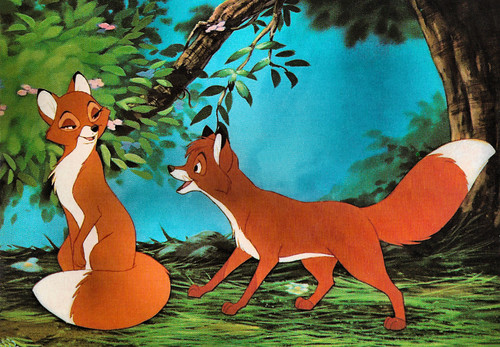
Italian postcard by Grafiche Biondetti, Verona. Photo: Walt Disney Productions. Photo: publicity still for The Fox and the Hound (Ted Berman, Richard Rich, Art Stevens, 1981).

Dutch postcard by Interstat, Amsterdam. Image: Disney. Publicity still for Pocahontas (Mike Gabriel, Eric Goldberg, 1995).

Dutch postcard by Donald Duck magazine. Image: Disney. Publicity still for The Lion King II: Simba's Pride (1998).

Danish postcard by Interstat. Photo: Disney. Johnny Depp as Jack Sparrow in Pirates of the Caribbean: Dead Man's Chest (Gore Verbinski, 2006).
Disney 50 movies / 50 filme celebration trailer (2010) Walt Disney Animation Studios. Source: moviemaniacsDE (YouTube).
The next six days, EFSP presents six film specials with Disney animation classics!
Sources: Wikipedia and IMDb.

Vintage postcard. In 1932, Walt Disney received an honorary Academy Award for creating Mickey Mouse.

German postcard by Ross Verlag, no. 5227/1, 1930-1931. Image: Walt Disney. Collection: Marlene Pilaete.

British postcard in the Picturegoer series. Image: Walt Disney. Collection: Marlene Pilaete.

German postcard by Ross-Verlag, Berlin, no. 5174/2, 1930-1931. Photo: Harlip, Berlin. Mickey surrenders Europe and Olga Tschechova.

French postcard by Editions Superluxe, Paris, no. 14. Image: Walt Disney - Micky Mouse S.A.. Publicity still for Snow White and the Seven Dwarfs (William Cottrell, David Hand, Wilfred Jackson, Larry Morey, Perce Pearce, Ben Sharpsteen, 1937). Caption: To reward her little friends, Snow White serves them a tasty dinner.
A Mouse named Mortimer
In early 1923, animator Walt Disney created a short film entitled Alice's Wonderland, which featured child actress Virginia Davis interacting with animated characters. After the bankruptcy in 1923 of his previous firm, Laugh-O-Gram Studio, Disney moved to Hollywood to join his brother, Roy O. Disney. Film distributor Margaret J. Winkler of M.J. Winkler Productions contacted Disney with plans to distribute a whole series of Alice Comedies purchased for $1,500 per reel with Disney as a production partner.
Walt and Roy Disney formed Disney Brothers Cartoon Studio that same year. More animated films followed after Alice. In January 1926, with the completion of the Disney studio on Hyperion Street, the Disney Brothers Studio's name was changed to the Walt Disney Studio. Hundreds of Alice Comedies were produced between 1923 and 1927, before they lost popularity.
After the demise of the Alice Comedies, Disney developed an all-cartoon series starring his first original character, Oswald the Lucky Rabbit, which was distributed by Winkler Pictures through Universal Pictures. The distributor owned Oswald, so Disney only made a few hundred dollars.
From 1927 on, Disney completed 26 Oswald shorts before losing the contract in February 1928, due to a legal loophole, when Winkler's husband Charles Mintz took over their distribution company. After failing to take over the Disney Studio, Mintz hired away four of Disney's primary animators (the exception being Ub Iwerks) to start his own animation studio, Snappy Comedies.
In 1928, to recover from the loss of Oswald the Lucky Rabbit, Disney came up with the idea of a mouse character named Mortimer while on a train headed to California, drawing up a few simple drawings. The mouse was later renamed Mickey Mouse and starred in several Disney produced films. Ub Iwerks refined Disney's initial design of Mickey Mouse.
Disney's first sound film Steamboat Willie (Walt Disney, Ub Iwerks, 1928), a cartoon starring Mickey, was released in 1928 through Pat Powers' distribution company. It was the first Mickey Mouse sound cartoon released, but the third to be created, behind Plane Crazy (Walt Disney, Ub Iwerks, 1928), and The Gallopin' Gaucho (Walt Disney, Ub Iwerks, 1928).
Steamboat Willie, with Walt as the voice of Mickey, was an immediate smash hit, and its initial success was attributed not just to Mickey's appeal as a character, but to the fact that it was the first cartoon to feature synchronised sound. Disney's Plane Crazy and The Gallopin' Gaucho were then retrofitted with synchronised sound tracks and re-released successfully in 1929.
Disney continued to produce cartoons with Mickey Mouse and friends, including Minnie Mouse, Donald Duck, Goofy, Pluto, and plenty more. He began the Silly Symphony series, a cartoon series that didn't have a continuous character, with Columbia Pictures signing on as Symphonies distributor in August 1929. In September 1929, theatre manager Harry Woodin requested permission to start a Mickey Mouse Club which Walt approved. In November, test comics strips were sent to King Features, who requested additional samples to show to the publisher, William Randolph Hearst. On 30 December, King Features signed its first newspaper, New York Mirror, to publish the Mickey Mouse comic strip with Walt's permission.
In 1932, Disney signed an exclusive contract with Technicolor (through the end of 1935) to produce cartoons in colour. The first, Flowers and Trees (Burt Gillett, 1932), was also the first cartoon to win an Oscar. Another cartoon, Three Little Pigs (Burt Gillett, 1933), was so popular it was often billed above the feature films it accompanied. Disney released cartoons through Powers' Celebrity Pictures (1928–1930), Columbia Pictures (1930–1932), and United Artists (1932–1937). The popularity of the Mickey Mouse series allowed Disney to plan for his first feature-length animation. Criticasters called it "Disney's Folly".

French postcard in the series The Wonderful World of Walt Disney by Editions Kroma, Caissargues, no. 203. Image: Walt Disney Productions. Publicity still for Snow White and the Seven Dwarfs (William Cottrell, David Hand, Wilfred Jackson, Larry Morey, Perce Pearce, Ben Sharpsteen, 1937).

Dutch postcard by Rembrandt Uitg. Mij, Amsterdam. Image: Walt Disney. Publicity still for Pinocchio (Hamilton Luske, Ben Sharpsteen, a.o., 1940). Caption: "And Pinocchio danced on stage with the Dutch marionette girls..."

French postcard in the series The Wonderful World of Walt Disney by Editions Kroma, Caissargues, no. 6. Image: Walt Disney Productions. Publicity still for Fantasia (James Algar, Wilfred Jackson, Hamilton Luske, Ben Sharpsteen, a.o., 1940). Hyacinth Hippo and alligator dance partner in the segment Dance of the Hours.

French postcard by Editions Superluxe, Paris, no. 22. Sent by mail in 1953. Image: Walt Disney Productions. Publicity still for Dumbo (Ben Sharpsteen, a.o., 1941). Caption: This is the big jump, Dumbo will fly? Timothy lodged in his hat is worried.

Dutch postcard by Rembrandt Uitg. Mij. Amsterdam, circa 1949. Publicity still for Bambi (David Hand, 1942). Caption: Eat as many vegetables as you can, Thumper says to Bambi.
Pushing the boundaries of Animation
Walt Disney decided to push the boundaries of animation further. He began production of his first feature-length animated film in 1934. Taking three years to complete, Snow White and the Seven Dwarfs (William Cottrell, David Hand, Wilfred Jackson, Larry Morey, Perce Pearce, Ben Sharpsteen, 1937), premiered in December 1937 and by 1939 became the highest-grossing film of that time. Snow Whitewas released through RKO Radio Pictures, which had assumed distribution of Disney's product in July 1937, after United Artists attempted to attain future television rights to the Disney shorts.
Using the profits from Snow White, Disney financed the construction of a new 51-acre (210,000 m2) studio complex in Burbank, California. The new Walt Disney Studios, in which the company is headquartered to this day, was completed and open for business by the end of 1939. The studio continued releasing animated shorts and features, such as Pinocchio (Hamilton Luske, Ben Sharpsteen, a.o., 1940), Fantasia (James Algar, Wilfred Jackson, Hamilton Luske, Ben Sharpsteen, a.o., 1940), Dumbo (Ben Sharpsteen, a.o., 1941), and Bambi (David Hand, 1942).
After World War II began, box office profits declined. When the United States entered the war after the attack on Pearl Harbor, many of Disney's animators were drafted into the armed forces. The U.S. and Canadian governments commissioned the studio to produce training and propaganda films. By 1942, 90% of its 550 employees were working on war-related films. Films such as the feature Victory Through Air Power (Perce Pearce, a.o., 1943) and the short Education for Death (Clyde Geronimi, 1943) were meant to increase public support for the war effort. Even the studio's characters joined the effort, as Donald Duck appeared in a number of comical propaganda shorts, including the Academy Award-winning Der Fuehrer's Face (Jack Kinney, 1943).
With limited staff and little operating capital during and after the war, Disney's feature films during much of the 1940s were 'package films', or collections of shorts, such as The Three Caballeros (Norman Ferguson, a.o., 1944) and Melody Time (Jack Kinney, Clyde Geronimi, Hamilton Luske, Wilfred Jackson, 1948), which performed poorly at the box office.
At the same time, the studio began producing live-action films and documentaries. Song of the South (Harve Foster, Wilfred Jackson, 1946) and So Dear to My Heart (Harold D. Schuster, Hamilton Luske, 1948) featured animated segments, while the True-Life Adventures series, which included such films as Seal Island (James Algar, 1948) and The Vanishing Prairie (James Algar, 1954), were also popular. Eight of the films in the series won Academy Awards.
The release of Cinderella (Clyde Geronimi, Hamilton Luske, Wilfred Jackson, 1950) proved that feature-length animation could still succeed in the marketplace. Other releases of the period included Alice in Wonderland (Clyde Geronimi, Wilfred Jackson, Hamilton Luske, 1951) and Peter Pan (Clyde Geronimi, Wilfred Jackson, Hamilton Luske, 1953), both in production before the war began, and Disney's first all-live action feature, Treasure Island (Byron Haskin, 1950). Disney ended its distribution contract with RKO in 1953, forming its own distribution arm, Buena Vista Distribution.
In December 1950, Walt Disney Productions and the Coca-Cola Company teamed up for Disney's first venture into television, the NBC television network special An Hour in Wonderland. In October 1954, the ABC network launched Disney's first regular television series.

Italian postcard by Grafiche Biondetti, Verona, no. 104. Picture: Walt Disney Productions. Publicity still for Cinderella (Clyde Geronimi, Wilfred Jackson, Hamilton Luske, 1950).

Italian postcard by Grafiche Biondetti S.R.L., Verona, no. 108/4. Image: Disney. Publicity still for Lady and the Tramp (Clyde Geronimi, Wilfred Jackson, Hamilton Luske, 1955).

French card by Jouets Masport, Chanas (Isère), no. 39/882. Photo: Walt Disney. Fess Parker and Buddy Ebsen in Davy Crockett - King of the Wild Frontier/Davy Crockett (Norman Foster, 1955).

French postcard by Editions Krõma, Paris in the Le monde merveuilleux de Walt Disney series. Illustration: Walt Disney Productions. Publicity still for One Hundred and One Dalmatians (Clyde Geronimi, Hamilton Luske, 1961).

Italian postcard by Grafiche Biondetti S.R.L., Verona, no. 116/1. Image: Disney. Publicity still for The Sword in the Stone (Wolfgang Reitherman, 1963).
Walt Disney's Magnum Opus
In 1954, Walt Disney used his Disneyland series to unveil what would become Disneyland, an idea conceived out of a desire for a place where parents and children could both have fun at the same time. In 1955, Disney opened Disneyland to the general public. After a shaky start, Disneyland continued to grow and attract visitors from across the country and around the world. In 1965, a second Disney theme park, Disney World', was announced, outside of Orlando, Florida.
Disney continued to focus its talents on television throughout the 1950s. Its weekday afternoon children's television program The Mickey Mouse Club (1955) was a great success, as was the Davy Crockett miniseries, starring Fess Parker and broadcast on the Disneyland anthology show. Two years later, Zorro (1957) would prove just as popular, running for two seasons on ABC.
Disney's film studios stayed busy as well, averaging five or six releases per year during this period. While the production of shorts slowed significantly during the 1950s and 1960s, the studio released a number of popular animated features, like Lady and the Tramp (Clyde Geronimi, Wilfred Jackson, Hamilton Luske, 1955), Sleeping Beauty (Clyde Geronimi, a.o., 1959) and One Hundred and One Dalmatians (Clyde Geronimi, Hamilton Luske, 1961), which introduced a new xerography process to transfer the drawings to animation cels.
Disney's live-action releases were spread across a number of genres, including the historical fiction film Johnny Tremain (Robert Stevenson, 1957), the children's book adaptation Pollyanna (David Swift, 1960) starring Hayley Mills, and the modern-day comedy The Shaggy Dog (Charles Barton, 1959), with Fred MacMurray.
Disney's most successful film of the 1960s was a musical adaptation of Mary Poppins (Robert Stevenson, 1964), which mixed live-action with animation. It is considered by many to be Walt Disney's magnum opus. Mary Poppins became one of the all-time highest-grossing films and received five Academy Awards, including Best Actress for Julie Andrews and Best Song for Robert B. Sherman & Richard M. Sherman for 'Chim Chim Cher-ee'.
In 1966, Walt Disney died of complications relating to lung cancer, and Roy Disney took over as chairman, CEO, and president of the company. One of his first acts was to rename Disney World as 'Walt Disney World' in honour of his brother and his vision. In 1967, the last two films Walt actively supervised were released, the animated feature The Jungle Book (Wolfgang Reitherman, 1967) and the musical The Happiest Millionaire (Norman Tokar, 1967).
The studio released a number of comedies in the late 1960s, including The Love Bug (Robert Stevenson, 1969), the year's highest-grossing film, and The Computer Wore Tennis Shoes (Robert Butler, 1969), which starred another young Disney discovery, Kurt Russell. The 1970s opened with the release of Disney's first 'post-Walt' animated feature, The AristoCats (Wolfgang Reitherman, 1970), followed by a return to fantasy musicals in Bedknobs and Broomsticks (Robert Stevenson, 1971) with Angela Lansbury.
In December 1971, Roy Disney died of a stroke. He left the company under control of Donn Tatum, Card Walker, and Walt's son-in-law Ron Miller, each trained by Walt and Roy. While Walt Disney Productions continued releasing family-friendly films throughout the 1970s, such as Escape to Witch Mountain (John Hough, 1975) and Freaky Friday (Gary Nielson, 1976) with Jodie Foster, the films did not fare as well at the box office as earlier material. However, the animation studio saw success with Robin Hood (Wolfgang Reitherman, 1973), The Rescuers (Wolfgang Reitherman, John Lounsbery, Art Stevens, 1977), and The Fox and the Hound (Ted Berman, Richard Rich, Art Stevens, 1981).
As head of the studio, Ron Miller attempted to make films to drive the profitable teenage market who generally passed on seeing Disney films. Inspired by the popularity of Star Wars (George Lucas, 1977), Disney produced the science-fiction adventure The Black Hole (Gary Nelson, 1979) that cost $20 million to make, but was lost in Star Wars' wake. Disney dabbled in the horror genre with The Watcher in the Woods (John Hough, Vincent McEveety, 1980) starring Bette Davis, and financed the boldly innovative Tron (Steven Lisberger, 1982) with Jeff Bridges, but both films were released to minimal success.

French postcard. Photo: Walt Disney Productions. Julie Andrews and Dick Van Dyke in Mary Poppins (Robert Stevenson, 1964).

Belgian postcard by Edicorna. Image: Walt Disney Productions. Publicity still for The Jungle Book (Wolfgang Reitherman, 1967).

Italian postcard by Grafiche Biondetti, no. 117. Illustration: Walt Disney Productions. Publicity still for The AristoCats (Wolfgang Reitherman, 1970).

Italian postcard by Grafiche Biondetti S.R.L., Verona. Image: Disney. Publicity still for Robin Hood (Wolfgang Reitherman, 1973).

French postcard by Les Presses de Belleville, Paris. Image: Walt Disney Productions, 1965. Publicity still for the short film Winnie the Pooh and the Honey Tree (Wolfgang Reitherman, 1966), later incorporated in the feature The Many Adventures of Winnie the Pooh (John Lounsbery, Wolfgang Reitherman, 1977).
The Michael Eisner Era
The 1983 release of Mickey's Christmas Carol began a string of successful films, starting with Never Cry Wolf (Carroll Ballard, 1983) and the Ray Bradbury adaptation Something Wicked This Way Comes (Jack Clayton, 1983). In 1984, Disney CEO Ron Miller created Touchstone Films as a brand for Disney to release more major motion pictures. Touchstone's first release was the comedy Splash (Ron Howard. 1984), which was a box office success. In 1980, Disney launched Walt Disney Home Video to take advantage of the newly emerging videocassette market. In 1983, The Disney Channel debuted as a subscription-level channel on cable systems nationwide.
Despite the success of the Disney Channel and its new theme park creations, Walt Disney Productions was financially vulnerable. Its film library was valuable, but offered few current successes, and its leadership team was unable to keep up with other studios, particularly the works of Don Bluth, who defected from Disney in 1979. By the early 1980s, the parks were generating 70% of Disney's income.
With the Sid Bass family purchase of 18.7 percent of Disney, Bass and the board brought in Michael Eisner from Paramount as CEO and Frank Wells from Warner Bros. as president. Eisner emphasised Touchstone with Down and Out in Beverly Hills (Paul Mazursky, 1985) to start leading to increased output with Good Morning, Vietnam (Barry Levinson, 1987), Dead Poets Society (Peter Weir, 1989), Pretty Woman (Garry Marshall, 1990) and additional hits.
Beginning with Who Framed Roger Rabbit (Robert Zemeckis, 1988), Disney's flagship animation studio enjoyed a series of commercial and critical successes with such films as The Little Mermaid (Ron Clements, John Musker, 1989), Beauty and the Beast (Gary Trousdale, Kirk Wise, 1991), Aladdin (Ron Clements, John Musker, 1992) and The Lion King (Roger Allers, Rob Minkoff, 1994). Disney moved to first place in box office receipts by 1988 and had increased revenues by 20% every year. In 1989, Disney signed an agreement-in-principle to acquire The Jim Henson Company from its founder, Muppet creator Jim Henson.
Disney also broadened its adult offerings in film when then-Disney Studio Chairman Jeffrey Katzenberg acquired Miramax Films in 1993. Wells was killed in a helicopter crash in 1994. Shortly thereafter, Katzenberg resigned and formed DreamWorks SKG because Eisner would not appoint Katzenberg to Wells' now-available post (Katzenberg had also sued over the terms of his contract). Instead, Eisner recruited his friend Michael Ovitz, one of the founders of the Creative Artists Agency, to be President. Ovitz lasted only 14 months and left Disney in December 1996.
In 2003, Disney became the first studio to record over $3 billion in worldwide box office receipts. Eisner did not want the board to renominate Roy E. Disney, the son of Disney co-founder Roy O. Disney, as a board director citing his age of 72 as a required retirement age. Stanley Gold responded by resigning from the board and requesting the other board members oust Eisner. On 30 November 2003, Disney resigned from his positions as the company's vice chairman and chairman of Walt Disney Feature Animation, accusing Eisner of micromanagement, failures with the ABC television network, timidity in the theme park business, turning The Walt Disney Company into a "rapacious, soul-less" company, and refusing to establish a clear succession plan, as well as a string of box office film flops starting in the year 2000.
In 2005, Walt Disney's nephew, Roy E. Disney, returned to the company as a consultant and as non-voting director emeritus. Walt Disney Feature Animation released Chicken Little, the company's first film using 3D animation. Bob Iger replaced Eisner as CEO. In January 2006, it was announced that Disney would purchase Pixar. Former Executive Vice-President of Pixar, John Lasseter, became Chief Creative Officer of Walt Disney Animation Studios, its division Disneytoon Studios, and Pixar Animation Studios, as well as assuming the role of Principal Creative Advisor at Walt Disney Imagineering.
In February 2006, Disney acquired the rights to Oswald the Lucky Rabbit from NBC Universal (including the character's intellectual property and the 26 Oswald cartoons produced by Walt Disney) as part of an exchange of minor assets. In 2009, Disney acquired Marvel Entertainment. Director Emeritus Roy E. Disney died of stomach cancer that year.
In 2018, Disney announced that Lasseter would be leaving the company. Pete Docter and Jennifer Lee replaced him as chief creative officers of Pixar and Disney Animation, respectively. In 2018, Disneytoon Studios was shut down, resulting in the layoffs of 75 animators and staff. Disney acquired 21st Century Fox. The acquisition lead to the formation of a new company, which kept the Walt Disney Company name.
In August 2017, Disney announced that they would be starting its own streaming service, known as Disney+, to compete with the longtime industry monopoly Netflix. Disney+ is currently scheduled to begin service in late 2019, with many series announced that will be using its many successful franchises. Disney currently has a publishing deal with Netflix to stream its content, however, Disney has said that its contract will end in 2019 and they won't renew it. Disney films and franchises will only be available via the new Disney+ subscription. The service will have content from Disney, Walt Disney Animation Studios, Pixar, Marvel, Star Wars, and National Geographic.

Italian postcard by Grafiche Biondetti, Verona. Photo: Walt Disney Productions. Photo: publicity still for The Fox and the Hound (Ted Berman, Richard Rich, Art Stevens, 1981).

Dutch postcard by Interstat, Amsterdam. Image: Disney. Publicity still for Pocahontas (Mike Gabriel, Eric Goldberg, 1995).

Dutch postcard by Donald Duck magazine. Image: Disney. Publicity still for The Lion King II: Simba's Pride (1998).

Danish postcard by Interstat. Photo: Disney. Johnny Depp as Jack Sparrow in Pirates of the Caribbean: Dead Man's Chest (Gore Verbinski, 2006).
Disney 50 movies / 50 filme celebration trailer (2010) Walt Disney Animation Studios. Source: moviemaniacsDE (YouTube).
The next six days, EFSP presents six film specials with Disney animation classics!
Sources: Wikipedia and IMDb.
No comments:
Post a Comment